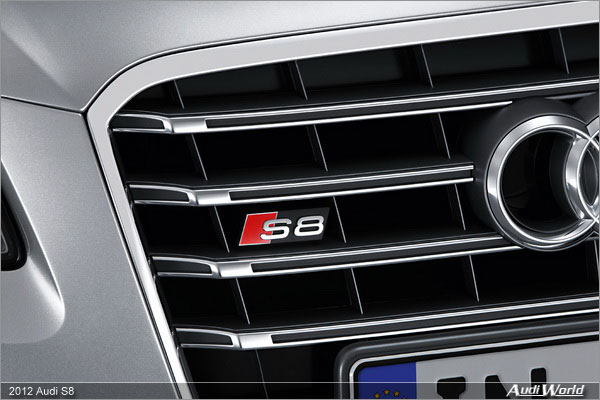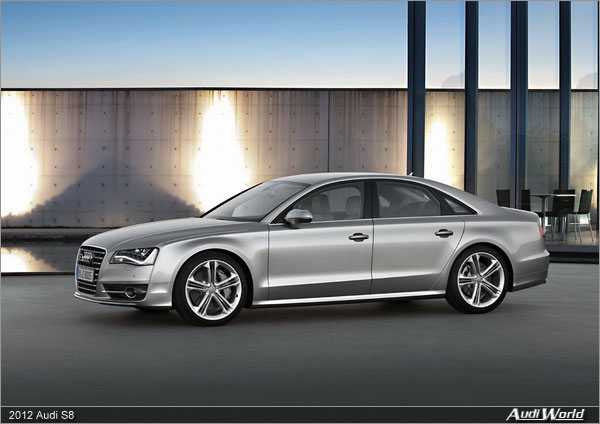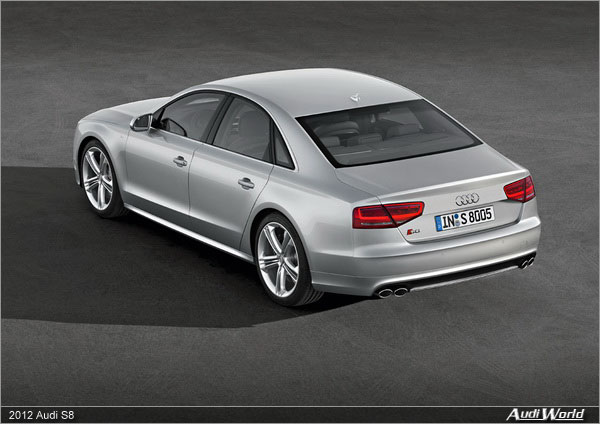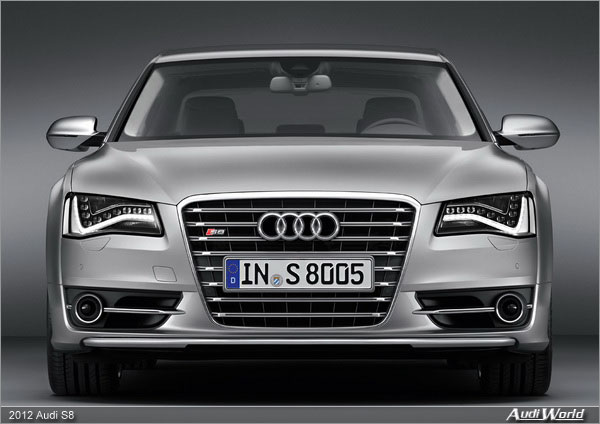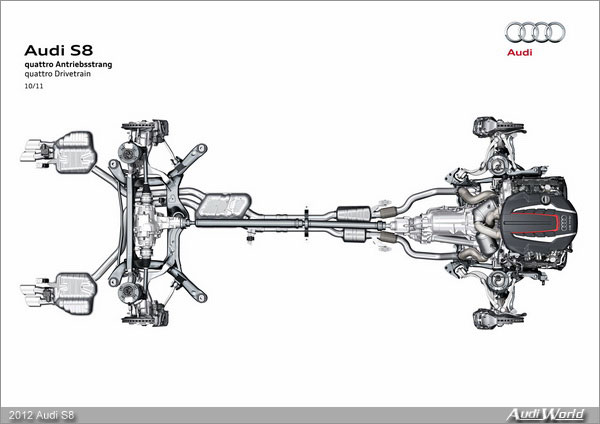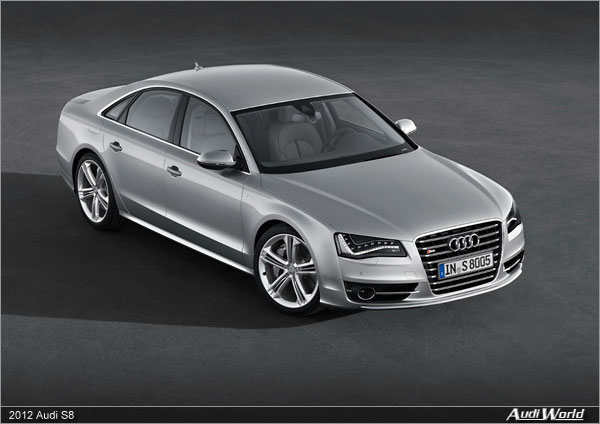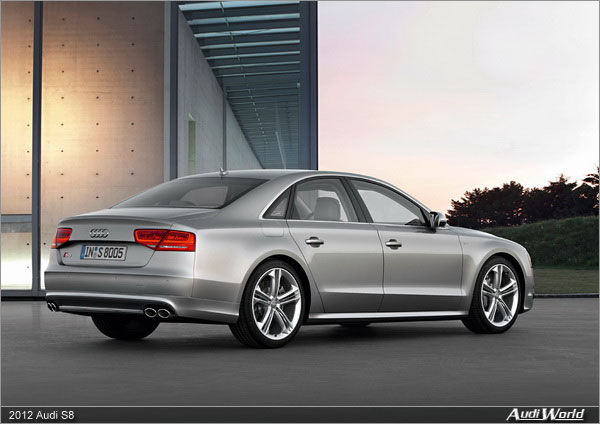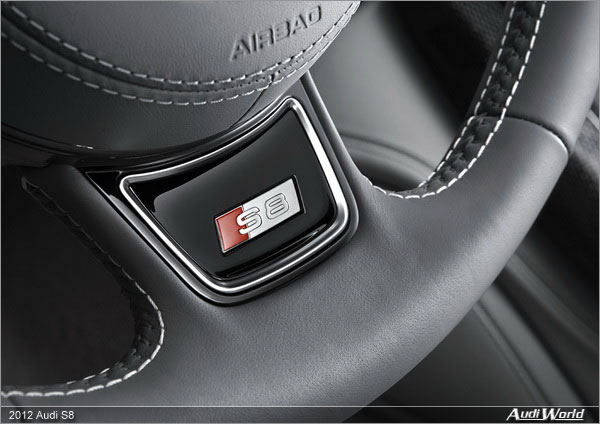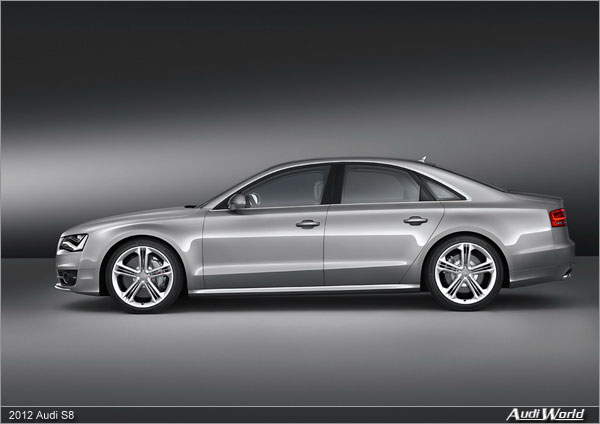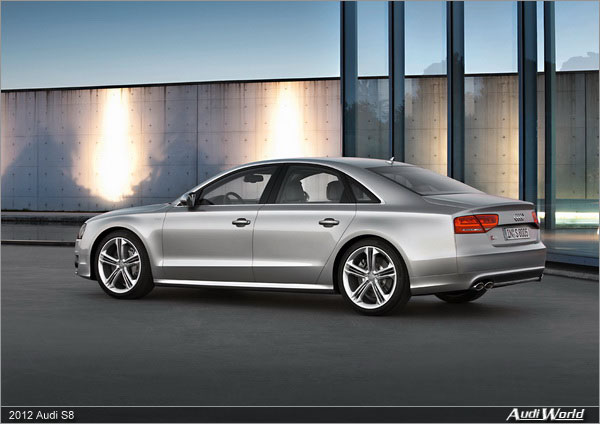The Audi S8 – luxurious sportiness
Cultivated dynamics and systematic efficiency the Audi S8 The new Audi S8 is a luxury sedan with superior dynamics. Its newly developed 4.0 TFSI develops an impressive 382 kW (520 hp), but consumes just 10.2 liters of fuel per 100 kilometers (23.06 US mpg) – thanks in part to new cylinder on demand technology. The advanced chassis, the ultra-lightweight aluminum body and the richly appointed interior round out the profile of the S8, a model athlete that is scheduled for market launch in early summer 2012.
The Audi S8, which will be launched on the market in early summer 2012, is the new head of the sporty Audi S model family – a large luxury sedan of outstanding power. Its newly developed 4.0 TFSI develops 382 kW (520 hp), but consumes just 10.2 liters of fuel per 100 kilometers (23.06 US mpg). This is due in large part to the cylinder on demand system, which deactivates four of the eight cylinders in many driving situations.
The 4.0 TFSI brings Audi’s downsizing strategy to the high-performance class. Twin turbocharging gives the V8, which displaces 3,993 cc, outstanding power. 650 Nm (479.42 lb-ft) of torque is continuously available between 1,700 and 5,500 rpm, and peak power (382 kW/520 hp) is developed at 5,800 rpm. The innovative cylinder head concept, with the intake side on the outside and the exhaust side on the inside, provides for short gas paths with minimal flow losses for very spontaneous engine response. The two twin-scroll turbochargers ensure prodigious amounts of torque at low revs.
The 4.0 TFSI accelerates the S8 from zero to 100 km/h (62.14 mph) in 4.2 seconds. The governed top speed of 250 km/h (155.34 mph) is just a formality. Compared to the engine in the previous model, the normally aspirated 5.2-liter V10, the twin-turbo V8 develops 51 kW (70 hp) or around 15 percent more power, yet consumes 3.0 liters less fuel per 100 kilometers (23 percent). With an average fuel consumption of 10.2 liters per 100 km (23.06 US mpg), the Audi S8 is significantly more fuel efficient than its competitors.
This top result can be attributed to numerous features, including a start-stop system. Playing a particularly large role in the S8’s high efficiency, however, is the new cylinder on demand technology. The system deactivates four of the eight cylinders at low load, reducing fuel consumption at moderate highway speeds by up to ten percent. When the V8 switches into V4 mode, the active noise control (ANC) system is activated, which uses targeted cancellation sound to eliminate unwanted sounds. In addition, active engine mounts dampen vibrations.
The eight-speed tiptronic in the S8 also unites sportiness and efficiency. It keeps revs low whenever possible, but downshifts quickly and comfortably when requested by the driver. The tiptronic delivers the power to a quattro drivetrain with a self-locking center differential with the sport differential at the rear axle. During dynamic driving, the lion’s share of the power flows to the outside wheel to literally push the large sedan into the corner.
Brimming with technology: the chassis
The Audi drive select dynamics system encompasses these two systems as well as engine management, the eight-speed tiptronic and the sport differential. The driver can vary the characteristic of these chassis components between the comfort, auto, dynamic, individual and efficiency modes.
The wheels of the new S8 measure 9 J x 20 and are shod with 265/40-series tires. Audi offers optional wheels measuring up to 21 inches in diameter. The matt black brake calipers on the front axle sport the S8 badge. Carbon fiber-ceramic discs are available as a high-end alternative. Each disc saves around three kilograms (6.61 lb) of weight, and their calipers are anthracite gray.
A particular advantage of the 5.15-meter (16.90 ft) S8 is its comparatively low weight of 1,975 kilograms (4354.13 lb). The luxury sedan’s ASF (Audi Space Frame) body is made almost entirely of aluminum. Only the B-pillars are made of ultra high-strength steel. The body weighs just 231 kilograms (509.27 lb); a conventional steel construction would be around 100 kilograms (220.46 lb) heavier.
Fine exterior design details signal the special position that the S8 occupies in the Audi range. The exterior color Prism Silver is reserved exclusively for the sports model.
The spacious interior is also upgraded with special accents. The multi-way, power-adjustable deluxe sport seats have been designed exclusively for the S8 and are optionally available with ventilation and massage functions.
The S8 offers a wide choice of interior colors, inlays and seat coverings, including particularly fine Valonea leather. The leather package, a DVD changer, the convenience key with sensor-controlled tailgate release and ambient lighting round out the list of standard interior equipment. The S8 is also equipped with the innovative LED headlights and double glazing.
Beyond the standard equipment, Audi makes all of the high-end options from the A8 series available. The driver assistance systems are closely networked with one another and the navigation system. These comprise the adaptive cruise control with stop&go function, Audi side assist, Audi lane assist, the speed limit display, the night vision assistant with highlighting of detected pedestrians and the new parking system with 360° camera. Supplementing these technologies is the safety system Audi pre sense, which is available in a number of versions. The S8 also comes standard with a break recommendation display and the sensor-controlled tailgate release introduced with the Audi A6 Avant.
Standard: MMI navigation plus and the Bluetooth online car phone
The Audi S8 will be rolling into showrooms in early summer 2012. Prices will start at 111,900 euros.
The Audi S8 Engine
Power transmission
Chassis
Body
Equipment
The new 4.0 TFSI from Audi combines supreme power with groundbreaking efficiency. It produces its rated output of 382 kW (520 hp) at 5,800 rpm. The twin-turbo V8 delivers a constant 650 Nm (479.42 lb-ft) of torque to the crankshaft between 1,700 and 5,500 rpm. Its average fuel consumption of just 10.2 liters per 100 km (23.06 US mpg) is much lower than that of its competitors. And compared to its predecessor, the new S8 consumes on average 23 percent less fuel.
The sonorous 4.0 TFSI has a displacement of 3,993 cc, a bore of 84.5 millimeters (3.33 in) and a stroke of 89 millimeters (3.50 in). As the youngest member of the large Audi family of V engines, the 4.0 TFSI has all of their typical features. The included angle between the cylinder banks is a classic 90 degrees. As a space-saving measure, the chain drive to the four camshafts and the auxiliaries is located at the rear of the engine.
The cylinder case is made from an aluminum-silicon alloy using a low-pressure chill casting process that achieves a high standard of homogeneity. The high proportion of silicon content makes the cylinder walls extremely resistant to wear. The bedplate – a stable frame for the crankshaft bearing bridges – further enhances the block’s rigidity. Weighing a good 220 kilograms (485 lb) including all key add-on parts, the V8 is very light.
Like almost every Audi engine, the new 4.0 TFSI also follows the principle of downsizing: Forced induction replaces displacement. This also harmonizes perfectly with FSI direct fuel injection. One twin-scroll turbocharger per cylinder bank compresses the fresh air. From each pair of cylinders, the exhaust ports lead separately to a manifold and the turbocharger housing; they are not combined until immediately ahead of the turbine.
The twin-scroll technology prevents the exhaust gas flows from influencing each other. The result is powerful torque build-up at an early stage when accelerating from idle speed. Even at 1,000 rpm, the 4.0 TFSI reaches a torque of roughly 400 Nm (295.02 lb-ft).
Special feature: turbocharger in the V, “cold side” on the outside
The fresh air system is mounted on the outside of the cylinder banks. Switchable flaps in the intake ports induce a rolling type of movement in the incoming air. The directly injected and intensively swirled fuel cools the combustion chambers.
The 4.0 TFSI employs all the technologies from Audi’s modular efficiency platform. They range from the start-stop system to a wide variety of measures aimed at reducing friction.
High-end technologies such as plate honing are used during assembly of the V8 at the Audi plant in Györ, Hungary. The piston pins have a fine, diamond-like carbon (DLC) coating.
The innovative thermal management system uses a ball valve to disconnect the water pump during the engine warm-up phase. Because there is no coolant flow at all through the engine, the oil reaches its operating temperature more quickly, shortening the phase in which high frictional losses occur. The demand-controlled oil pump varies oil pressure in two stages.
Attractive innovation: the cylinder on demand system
If these preconditions are satisfied, the system closes the intake and exhaust valves of cylinders 2, 3, 5 and 8 on both banks. The V8 continues to run as a V4 with a regular firing order (1 – 4 – 6 –7), but with only two cylinders instead of four being ignited on each revolution of the crankshaft. Efficiency in the active cylinders is increased because the operating points are displaced toward higher loads.
The valves on the four camshafts are closed by an enhanced version of the Audi valvelift system (AVS). Its sleeves can be slid sideways electromagnetically, and have “zero-lift cams” as additional profiles.
Since these do not move the cam followers as they rotate over them, the valve springs keep the valves closed. At the same time, the engine management system shuts down fuel injection and ignition. Four-cylinder status is indicated to the driver on the instrument cluster’s driver information system display. The fuel consumption indicator bars turn green and a text message is also displayed.
In the deactivated cylinders, the pistons continue to move because they are being driven by the crankshaft. Before the valves close, the combustion chambers are again filled with fresh air. This intake of fresh air minimizes pressure in the cylinder and reduces the energy needed to move the pistons accordingly – an important factor for increased efficiency.
As soon as the driver presses firmly down on the gas pedal, the deactivated cylinders cut in again. The return to eight-cylinder operation, like the cylinder deactivation process, takes place so smoothly and quickly that it is essentially imperceptible. The changeover takes between just one hundredth and nearly four hundredths of a second, depending on the operating point. The changeover is accompanied by parallel interventions in the ignition and the throttle valves, resulting in a temporary drop in efficiency during the transitional phase.
Audi has therefore developed a control logic that monitors the movement of the accelerator and the steering wheel by the driver. Cylinder deactivation may be inhibited if an irregular pattern is detected, for instance at a roundabout or when the car is driven hard on interurban roads. Cylinder deactivation lasting only a few seconds would tend to increase fuel consumption rather than reducing it.
Savings: more than ten percent at 100 km/h
Four-cylinder engines generally do not run as smoothly as classic V8 engines, and this is also true of the new 4.0 TFSI when the cylinder on demand system is active.
During these phases, the crankshaft drive produces higher torsional vibrations as a function of load and engine speed. These vibrations penetrate into the cabin in the form of solid-borne sound and the resultant airborne sound. The large exhaust system also emits certain thrumming noises that cannot be suppressed completely despite intelligent flap control.
The new Audi active noise control (ANC) technology counteracts unwanted noise by generating a targeted cancellation sound. This principle is known as destructive interference: If two waves of the same frequency are superimposed, their amplitudes – the peaks and troughs that determine the sound pressure – cancel each other out. The amplitudes must be of the same strength and the phases opposed by 180 degrees.
In the Audi S8, four small microphones are integrated inconspicuously into the headlining. Each of them registers the complete noise spectrum in its immediate area. From these signals the ANC control unit computes a highly differentiated spatial sound image; information on actual engine speed is also obtained from the crankshaft sensor. In all of the previously calibrated zones in which the system identifies disturbing noise, it emits a precisely modulated cancellation sound. The ANC must react particularly quickly and accurately during the moments in which cylinder deactivation or reactivation takes place.
The cancellation sound is played through the speakers of the sound system. Because each microphone and each speaker must cover a certain area, there is a slight fuzziness. The cancellation sound therefore does not completely eliminate the disturbing noise, but reduces it until the vehicle occupants can no longer hear it. ANC is always active, regardless of whether the sound system is on or off, or volume is set to loud, soft or mute. It works with both of the available sound systems.
Vibration killers: active engine mounts
The control units for the active engine mounts receive their information from two sources. Engine speed is detected by the crankshaft sensor; these signals are used to compute the precise phase and frequency of the actuator signal. Acceleration sensors on the two engine mounts supply the data that determine the amplitude necessary to cancel out the vibration. The active engine mounts are also active at idle speed with all eight cylinders in operation. In this case they largely eliminate engine excitation of the fourth order.
Audi normally uses firm, sporty settings for its engine mounts. For many years now, Audi has therefore used switchable electromagnetic mounts in certain models and with certain engines. These have two operating settings: During idling, their soft characteristics keep disturbing noises and vibrations away from the interior; during driving the damping is increased, in order to suppress engine vibrations.
Drivetrain: highly flexible, eight-speed tiptronic
The eight-speed tiptronic impresses with a high level of efficiency. One of the key elements to this efficiency is an efficient oil pump that reduces friction losses. A hydraulic impulse storage unit enables the start-stop function. For the restart, its oil volume is pressed into the system by spring pressure – meaning that the tiptronic is ready to start in no time.
The dynamic shift program (DSP) that controls the eight-speed tiptronic features the automatic operating modes D and S. It uses high gears at low revs whenever possible, but downshifts quickly and flexibly when needed. The DSP has access to the route data from the standard MMI navigation plus. The computer uses this data to incorporate upcoming curves into its gearshift strategy – allowing it to avoid unnecessary gear changes on meandering roads, for example.
If the driver wants to intervene, he or she can use the paddles behind the steering wheel or the lever on the center tunnel. It resembles the thrust lever of a yacht, and the integrated gear indicator is lit internally in red. The lever communicates with the transmission purely electronically. Gear changes are triggered by a brief tap of the lever, after which it automatically returns to its center position.
As in nearly every Audi model with a longitudinal engine, the eight-speed tiptronic is installed with a special layout: The differential is located in front of the torque converter.
The front axle is then moved far forwards – the advantages are a long wheelbase, a short front overhang and a finely balanced weight distribution. The rear axle differential in the quattro powertrain and the battery in the trunk also factor into this balance.
The heart of the quattro permanent all-wheel drive system in the S8 is a self-locking center differential. The purely mechanical planetary gear normally sends 60 percent of the torque to the rear axle differential and 40 percent to the front. If one wheel slips, the differential transfers most of the power to the axle with the better traction. Up to 80 percent can be directed to the rear wheels and up to 70 percent to the front wheels.
Standard: the sport differential
When the clutch closes, it steplessly forces the higher speed of the superposition gear onto the wheel. The additional torque is drawn off of the opposite wheel via the differential. In this way nearly all of the torque can be directed to one wheel. The maximum difference between the wheels is 1,800 Nm (1,327.61 lb-ft).
In fast curves, the sport differential literally pushes the sedan into the radius so that the S8 corners as if on rails. The system nips any tendency toward oversteer or understeer in the bud. Thanks to its short reaction time – less than 100 milliseconds – it works even faster than the ESP stabilization system. It is just as effective while coasting as it is under load. Control of the sport differential is integrated into the standard Audi drive select system.
Complementing the sport differential on the front axle is torque vectoring. This software solution monitors whether the front inside wheel in a curve is about to slip. In this case, it pulses the brakes very slightly so that the outside wheel can transfer more power to the road. The system improves handling, safety and traction.
The Audi S8 is the dynamic top model of the A8 family, combining the comfort of a luxury sedan with amazingly sporty handling. Its sophisticated chassis combines high precision with supreme stability and an excellent ride.
All wheel control arms and many other components are made of aluminum. The track measures 1,644 millimeters (64.72 in) up front and 1,635 millimeters (64.37 in) at the rear. The front suspension comprises five links per wheel – two transverse links on the upper plane, the support link and control arm in the lower plane, and the track rod.
The five-link design can handle longitudinal and lateral forces separately. Their bearings are stiff in the lateral direction, enhancing sporty precision; on the other hand, the bearings are remarkably pliable in the longitudinal direction. The axle links are aluminum forgings; they keep the unsprung masses low. The anti-roll bar fabricated from a high-strength tube also saves weight.
Made of high-strength steel and reinforced with X-shaped braces, the integral subframe for the engine and the front axle forms the backbone of the suspension. Because it is rigidly bolted to the front end of the car, it becomes an integral component of the body. The high rigidity ensures that steering forces develop without delay. A diecast strut brace further enhances the rigidity of the front of the car.
The rear suspension of the new S8 follows the track-controlled trapezoidal link principle, a compact design that ensures superior driving and comfort qualities. The two trapezoidal links are warm-hardened aluminum castings; the wheel carriers are of chill-cast aluminum. The top transverse links and the track rods are aluminum forgings; the stabilizer bar is also a tube.
The struts act directly on the wheel carriers. This allows a high damping ratio so that the dampers react sensitively. The developers were also able to redesign the axle beam bearings to be more comfortable. The beam comprises two steel longitudinal and lateral beams each; four hydraulic bearings connect them to the body.
Versatile: the adaptive air suspension
The adjustable two-tube shock absorbers inside the struts are characterized by their low friction. Supplied with data from a complex system of sensors, the control unit adapts the function of the shock absorbers to the road conditions, the driver’s style, and the mode specified in the Audi drive select system. Individual adjustments for each wheel are made continuously by the millisecond via the control current for the damper valves.
The driver can choose between four different modes for the adaptive air suspension in Audi drive select. Changing modes changes the response of the shock absorbers and the ride height, which is already ten millimeters (0.39 in) lower than on the Audi A8. In auto and dynamic modes, the body is lowered by a further 10 millimeters (0.39 in) once the S8 has driven longer than 30 seconds at a speed greater than 120 km/h (74.56 mph). This increases stability and reduces drag, thus saving fuel. In lift mode, ground clearance increases by 25 millimeters (0.98 in) from the standard ride height so that smaller obstacles can be overcome.
The standard Audi drive select system makes driving an even more versatile experience. In addition to the adaptive air suspension, it also integrates engine management, the eight-speed tiptronic, the dynamic steering, the sport differential, the ambient lighting and the Audi pre sense basic safety system.
The driver can vary the function of these components between the three modes comfort, auto and dynamic. Drivers can – within certain limits – also compose an individual mode corresponding to their own personal preferences. The fifth mode, efficiency, promotes an economic driving style. In this mode, Audi drive select also controls the deluxe automatic air conditioning and the ACC with stop&go function accordingly.
Variable ratio: dynamic steering
At the cornering limit, the dynamic steering helps the driver to cancel out understeer and oversteer by performing tiny steering corrections autonomously. It also prevents the car from pulling to one side when braking on surfaces with different coefficients of friction. The system needs less time for such corrections than the brake system needs to develop pressure at the wheels. In many cases it does most of the work virtually unnoticed by the driver.
The hydraulic dynamic steering system receives its energy from a regulated vane-type pump, which provides only as much fluid as is required at any specific moment. The steering gear, a rack-and-pinion construction, is mounted on the subframe down low and far to the front. The track rods communicate the steering input very directly to the wheels.
The Audi S8 comes equipped with a powerful, durable and lightweight brake system. All discs are internally vented; the front discs are also perforated. Stainless steel pins connect the cast-iron friction rings to the aluminum brake caps – a concept from sports car design that prevents the transfer of temperature peaks, reduces the risk of fading and reduces weight.
The front discs measure 400 millimeters (15.75 in) in diameter; the rear discs 356 millimeters (14.02 in). Six-piston calipers painted matt black and sporting S8 logos are used up front, with single-piston calipers at the rear. Audi offers carbon fiber-ceramic discs with anthracite gray calipers as an option. They are particularly robust and durable, and together they are roughly 13 kilograms (28.66 lb) lighter than steel discs.
The ESP stabilization system is state of the art and works closely together with the dynamic steering, the sport differential and the adaptive dampers. The ESP in the S8 includes a sport mode, in which the system intervenes significantly later. A trailer stabilization system and tire pressure indicator are also standard. Another standard feature, the auto release function, facilitates starting off on hills.
The wheels of the S8 feature a five parallel-spoke design, typical of the S models from Audi. They measure 9 J x 20 and are fitted with 265/40-series tires. Audi offers five additional wheels as options, four of which measure 21 inches in diameter. They come in a choice of attractive designs: polished, high-sheen or two-color. Winter wheels are available in 19 and 20 inch sizes. A tire repair kit comes standard; a space-saving spare tire is available for no additional charge.
5,146 mm (16.88 ft) in length, with a 2,994 mm (9.82 ft) wheelbase, 1,949 mm (6.39 ft) in width and 1,458 mm (4.78 ft) in height – the new Audi S8 boasts generous proportions. It is significantly longer than its competitors.
The lines document Audi’s leading role in automotive design. The outer skin conveys homogeneity, as if modeled from a solid volume. A coupe-like roof line lets the silhouette flow; sculptured surfaces contrast with sharp lines. The bold design in aluminum demands uncompromising precision and a high level of expertise at every step of the manufacturing process.
The frame of the single-frame grille is platinum gray and its eight horizontal double bars are covered in chrome. With the slightly angular upper corners, the grille is neatly integrated in the front section. The edge of the engine hood intersects lightly with the tops of the headlights. Horizontal aluminum-look ribs structure the large air inlets, whose slats are painted in high-gloss black. An aluminum-look edge lends a sharp contour to the lower section of the bumper.
The contoured flanks of the S8 are sporty and elegant, with accents provided by body-color trim strips on the sills, aluminum strips on the door handles and polished aluminum-look mirror housings. V8 T badges adorn the fenders and the trunk lid.
The diffuser insert at the sculpted back of the car includes a lip with a two-layer aluminum-look finish offset with parts in platinum gray. The exhaust system ends in two oval dual tailpipes in a chrome-look finish.
Broad palette: 13 paint colors
The last color is reserved for the S8, as is the crystal effect finish Prism Silver. Even more exclusive are the paint finishes available as part of the Audi exclusive program, which Audi mixes specially upon the customer’s request.
Another highlight of the Audi S8 are the standard LED headlights, which use light-emitting diodes for all functions. With a color temperature of 5,500 Kelvin, their light resembles daylight and hardly fatigues the eyes. The LED headlights, each of which integrates 76 light-emitting diodes and contain no moving parts, are designed for the life of the vehicle. Their energy consumption is minimal, with the low beams requiring just 40 watts per unit. The integrated high-beam assistant switches automatically between the high and low beams.
The flat, wide rear lights of the S8 generate a seemingly three-dimensional light pattern. They are realized almost entirely with LED technology, with each unit containing 72 light-emitting diodes. The tail light forms a trapezoidal contour that appears as a homogenous band thanks to a light guide and a free-form surface. The adaptive brake light is located inside the trapezoid. When the S8 decelerates strongly, the brake light flashes quickly, and the hazard warning lights are activated if the car then comes to a stop.
The aluminum body of the new Audi S8 is strong, sturdy and amazingly light. Its weight of just 231 kilograms (509.27 lb) is a key reason for the sport sedan’s dynamics and efficiency. Including the standard quattro drive, the S8 has a curb weight of just 1,975 kilograms (4,354.13 lb).
The body in Audi Space Frame (ASF) technology is roughly 40 percent lighter than a comparable steel body. Its layout follows bionic principles. The skeleton comprises extruded sections and pressure diecast parts of aluminum; the aluminum panels are joined to it using friction connections. Like the bones in a skeleton, all of the components combine optimal function with low weight. The material is used only where necessary and always in a tailored configuration.
The most recent stage in the evolution of the ASF principle is composite construction with steel to further improve crash safety. The B-pillars of the S8 are made of hot-shaped steel. The blanks are heated in a pass-through furnace to roughly 900 degrees Celsius (1,652 degrees Fahrenheit) and fed into the press directly thereafter. The blank is then quenched to approximately 200 degrees Celsius (392 degrees Fahrenheit) in the cooled die, creating a structure with extremely high tensile strength. This measures 1,500 Newtons per square millimeter in the upper section of the pillars; somewhat lower in the lower section because this is where most of the energy is dissipated in the event of a side impact collision.
The hot-shaped B-pillars make up eight percent of the weight of the S8 body’s material matrix, with most of the rest being aluminum – 35 percent panels, 35 percent cast components and 22 percent extruded sections. Joining these wrought components and individual parts is a high-tech process. Audi uses a wide variety of joining techniques – punch riveting, self-tapping screws, spot welding, MIG welding, laser welding and combined bonding.
Laser welding is an Audi domain. Because the seams exhibit high strength and rigidity, it can be used to join large panels to the structure. One area where laser welding is used is the aluminum invisible seam between the roof and the side of the car.
This is an area at the focus of all of Audi’s precision during the design and body assembly processes – the maximum tolerance for the outer skin is only 0.1 millimeters (0.004 in).
The ASF body is not only lightweight, it is also very rigid. Its static torsional stiffness has increased by 25 percent versus the predecessor, which was already a leader in the field. Dynamic torsional rigidity has improved by 15 percent, and lightweight quality – the relationship between weight, torsional stiffness and size – by 20 percent.
The ASF principle ensures comfortably low levels of vibrations and a tranquil interior free of disturbing vibrations or noises. The windows of the S8 also contribute to comfort, with double/acoustic glazing standard. Audi also offers infrared-insulating and heated windshields as options; dark privacy glazing for the rear windows is another option.
Highly tuned: the aerodynamics
The ASF body of the S8 offers extremely good protection in the event of a collision. In a frontal collision, four load paths distribute the forces optimally to each side of the vehicle. A cross-member manufactured out of a double-box section and bent into the shape of an omega provides additional protection for the passenger cell. The longitudinal members in the floor panel come together in the shape of an arrow below the rear bench seat. Together with the center tunnel they constitute the body’s strongest node. The longitudinal members in the rear are large.
Standing guard in the large sedan’s cabin is the adaptive restraint system. It is networked with the Audi pre sense safety system and draws its own information from eight sensors. It intelligently manages the interplay between the airbags and the belt force limiters to offer outstanding protection to passengers of any size. In a rear-end crash, the integral head restraint system works together with the seat backs to avert the danger of whiplash injuries.
All Audi models are equipped with four side airbags to support the hips and chest of the occupants in the event of a side-impact collision. The head airbag system spans the area from the A-pillar to the C-pillar and opens like a curtain. All of the seats in the new Audi S8 have three-point automatic seatbelts with tension limiters. Isofix child seat anchors in the rear are standard. A deactivation function for the passenger-side airbag is available for an extra charge.
To help hold down the cost of repairs, the aluminum crash boxes bolted in front of the cross-members at both the front and at the rear of the car are relatively easy to replace.
The interior of the Audi S8 enchants with its generous spaciousness and elegant design. Its dominant feature is the “wrap-around.” The curve encircling the entire interior forms an elegant beltline as on a yacht, putting the crowning touch on the concept of sinewy taut and wedge-shaped lines.
The large curve integrates a sleek and low instrument panel. Its front is shaped like a gentle wave flowing around the driver and the front seat passenger; the horizontal line underscores its width. A classic analogue clock is inset into the center of the panel.
At dark, another artistic feature comes into play – the standard ambient lighting. LEDs, fiber optics and light strips illuminate a number of areas of the cabin. The center console appears to float. Many of these LEDs are two-colored or three-colored – the driver can use the MMI to choose between three color schemes (Polar, Ivory or Ruby/Polar) and adjust the brightness in four zones.
The rear seats treat their comforts to excellent comfort and ample room. Audi also offers the option of two power-adjustable individual seats with three-stage heating. The individual seats are available in conjunction with a memory function, a deluxe center armrest, four-zone automatic air conditioning and power blinds in the rear. Rounding out the list are deluxe headrests with adjustable side bolsters and a passenger seat that can adjusted from the rear seat.
The individual seats can also be equipped with an optional ventilation and a pneumatic massage function with two selectable programs and three intensity levels for even greater luxury. Other high-end features for the rear are folding tables from the Audi exclusive program.
22-way adjustment: the deluxe sport seats
The most important adjustments are made using buttons on the consoles. Secondary functions are controlled via a multifunction switch, with each step visualized on the MMI monitor. An optional massage function is also available. Ten pneumatic pillows massage the muscles according to one of five programs and in five intensities. Another luxurious extra is the three-stage ventilation system, in which four small fans draw off the air.
The deluxe sport seats feature carbon inlays on the seat backs. They are covered in perforated Valcona leather; the center strips feature a sporty diamond pattern designed specifically for the S8. Audi also offers the seat coverings in an Alcantara/leather combination at no extra charge.
Options include natural leather and Valonea leather, which is tanned naturally. It is particularly breathable and has an authentic surface structure. The headrests, the tiptronic selector lever and the additional loose cushion in this case are covered with deerskin Nappa leather, an amazingly soft material.
Minimal distraction: display and control concept
The driver information system includes the efficiency program, which also indicates the status of the cylinder on demand engine technology. When the car is started, it greets the driver with an S8 emblem on the monitor.
The driver information system is controlled using the leather multifunction sport steering wheel, which is available in a choice of three-spoke (standard) or four-spoke (optional) designs. The steering column is power-adjustable, with a heated rim available as an option. A red ring frames the start button. It and the latch for the electromechanical parking brake are mounted on the center tunnel console. Red LEDs illuminate the button from within. The letters have been machined with precision from the aluminum surface.
The deluxe automatic air conditioning is extremely discreet. A grate on the top of the instrument panel provides for quiet and virtually draft-free ventilation. It offers three air-conditioning styles and a fourth version for the winter. Audi also offers the S8 with an optional four-zone automatic air conditioning system and an auxiliary heating system with an intelligent programming function.
Three regions: the MMI navigation plus terminal
When inactive, the eight-inch monitor of the MMI navigation plus is retracted into the instrument panel, with only its top edge visible as a chromed trim strip. Switched on, the monitor moves upwards in an elegant curve and presents a special S8 startup screen. As with the driver information system, the display area is divided into three zones, with all topics represented by three-dimensional graphics.
Quality is uncompromising. The combination of premium materials, their look and their feel are responsible for the rich, handcrafted atmosphere on board the Audi S8. The air vents are covered in part with chrome. The edges of the veneers are reworked by hand following machine grinding, and the leather cover on the steering wheel rim is hand-stitched. All of the switches move easily and without play; gaps are parallel and narrow.
Carbon and aluminum: inlays
The door sill trims feature illuminated S8 logos, and a thin, durable coating protects them against damage. Another highlight is an extended aluminum-look interior trim package, in which the pedals, the shift paddles on the steering wheel and numerous components in the doors and on the instrument panel are adorned with chrome or aluminum – some brushed, and some polished. Many other buttons have an appealing high-gloss black finish. A UV-cured topcoat makes heavily used components extremely scratch-resistant.
The leather package is standard in the S8 – the center tunnel console, the armrests in the doors and the airbag cap are covered in Fine Nappa leather with decorative stitching. The steering wheel with the S8 badge includes color-contrasting stitching, and the inside door panels are lined with Alcantara.
A number of leather packages from the Audi exclusive program plus an Alcantara package are available as options. A wood veneer steering wheel rim is available, and the tiptronic selector lever is available in wood or leather at no extra charge.
The Audi designers have come up with four basic colors for the interior: the typical black of the S models, plus steel gray, moor brown and granite gray. These can be combined with the shades titanium gray, nougat brown, balao brown, silk beige, velvet beige, brass beige and snow white. The leather seat covers are available in eight colors – black, titanium gray, nougat brown, balao brown, silk beige, velvet beige, brass beige and lunar silver. The latter shade is exclusive to the S8 and features stitching, piping and center strips in the contrasting color steel gray.
Audi has also developed two design selections – design worlds for individualists – around the colors balao brown and brass beige. The headlining, the inlays and the contrasting stitching set powerful accents here. Both design selections are combined with a series of luxurious appointments.
Extremely comfortable: standard equipment
The Audi S8 provides 510 liters (18.01 cu ft) of luggage space. Its trunk has a low loading edge and is cut very wide. Four golf bags can be fitted crosswise; smaller objects are accommodated in the side compartments. The trunk lid swings upward when unlocked. Pull the lid down and the self-closing trunk does the rest.
The optional trunk package includes a floor net, two hooks for bags, an umbrella holder and a 12 V outlet. Also available are a load-through hatch with ski bag, a refrigerator box, a power trunk lid and a power-retractable trailer hitch. The range of accessories includes a semi-rigid trunk liner and a variety of roof racks.
The Audi S8 will be rolling into showrooms in early summer 2012. Prices in Germany will start at 111,900 euros.
The optional high-tech assistance systems that Audi offers for the S8 make driving even easier, more relaxing and more composed. Their tight networking among themselves makes them particularly powerful. The Audi pre sense safety system is available in the standard version and three extended versions.
The central assistance system is Audi adaptive cruise control with stop&go function, a radar-assisted distance control system. Using two radar sensors that cover a wedge-shaped, 40 degree field 250 meters (820.21 ft) long, it controls the speed and the distance to the car ahead at speeds between 0 and 250 km/h (155.34 mph). It accelerates and brakes autonomously within certain limits, with maximum deceleration limited to 4 meters/s2.
The driver can set the time interval to the vehicle ahead in four steps and also specify one of three levels for the control dynamics.
When creeping along in traffic or in the city, ACC stop&go brings the large sedan to a stop with no input from the driver. If the stop is brief, the S8 automatically resumes moving again; after a longer stop the driver must tap the accelerator or the cruise control lever.
The adaptive cruise control with stop&go function uses the predictive route data from the MMI navigation plus system, and works closely with the other assistance systems. It uses the data from as many as 27 control units to continuously analyze the vehicle’s surroundings. Thanks to this high volume of information, it can also provide predictive support even in complex situations, reacting very similarly to a skilled driver.
The lane change assistant Audi side assist activates at speeds above 30 km/h (18.64 mph). Two radar sensors in the rear monitor events behind the S8 to a distance of about 70 meters (230 ft). If a critical situation arises because another car is cruising in the blind spot or approaching quickly, a yellow LED indicator lights up in the frame of the side mirror.
If the driver nonetheless activates the turn signal to change lanes, the indicator becomes brighter and begins to flash quickly – a signal that is hard to miss.
At above roughly 65 km/h (40.39 mph), Audi lane assist issues a warning if the driver is about to leave the lane inadvertently. A camera in front of the interior mirror monitors the road to distance of 60 meters (196.85 ft), and software detects the lane markings. If the S8 approaches a lane marking without indicating, Audi lane assist warns the driver by vibrating the steering wheel. The intensity and timing of the vibration can be set in three stages.
The images from the camera also benefit another assistance system: The speed limit display shows the current speed limit in the instrument cluster. In addition to speed limit signs, the system also recognizes digital speed limit displays and pictogram-based supplemental signs.
The software compares this information against additional data, such as that from the MMI navigation plus, and also draws on additional information from the vehicle, such as whether the windshield wipers are on and the current time.
An indicator recommending breaks is available for the first time ever in the S8. The system uses a variety of parameters such as steering motions to detect symptoms of fatigue and warns the driver via a display in the driver information system.
Greater foresight in the dark: the night vision assistant
While the cooler surroundings appear dark, animals and people appear strikingly bright. The image-processing software detects people up to 100 meters away and highlights them with yellow markings on the display. If the computer assumes a hazardous situation, the person is marked red and a warning gong sounds.
With its 24 degree angle of aperture, the far infrared camera can look ahead up to 300 meters (984 ft), far beyond the high beam range. A window protects it against stone chipping; it is heated in cold weather and cleaned when dirty. Like every assistance system, the night vision assistant also works within certain system limitations.
Audi offers a variety of parking systems in the S8. The parking system plus uses eight ultrasonic sensors to indicate the distance acoustically and graphically on the large onboard display. The parking system plus with reversing camera uses an extremely light-sensitive camera that shows a wide area. The images generated by this camera are processed to remove distortion and displayed on the monitor. Guidelines and fields show the driver the car’s projected path.
The top version in the lineup is the parking system plus with 360° camera. Four small cameras – in the single-frame grille, in the rear and in the housings of the side mirrors – record images of the S8’s immediate surroundings and a computer stitches them together. The driver can call up a variety of views on the onboard monitor, including a top-down view. For narrow exits, there are special views that show the area in front of and behind the sedan and also allow a look at cross-traffic.
The safety system Audi pre sense basic is standard in the Audi S8. If the ESP stabilization program indicates a critical situation, such as skidding or maximum braking, its control unit intervenes. Depending on the situation, it activates the hazard warning lights and closes the side windows and the sunroof; it also partly or fully tensions the front seat belts. Small electric motors trigger this process, which is reversible; if the situation is averted without an accident, the belts are released again.
Protection against colliding with the vehicle ahead: Audi pre sense front
Parallel to this, the brake system is prefilled and the air springs and dampers of the suspension are set to hard. The warning is intended to persuade the driver to apply the brakes or take evasive action, which is often the better choice.
If the driver remains passive, the acute warning – a warning jolt produced by the rapid generation of pressure in the brake system – is issued in stage 2. The seatbelts are lightly tensioned at the same time. If the driver now depresses the pedal, the hydraulic brake assist system handles precise braking relative to the preceding vehicle. The fact that the system is already prefilled saves between 0.1 to 0.2 seconds, or more than seven meters (22.97 ft) at a speed of 130 km/h (80.78 mph).
Should the driver also ignore the warning jolt, the third stage is activated – partial braking that initially slows the S8 at a rate of 3 m/s2. The windows and sunroof are closed, and the hazard warning lights are activated.
If the sedan is equipped with the top-of-the-range safety system – Audi pre sense plus, which is part of the assistance package – a fourth stage follows, if necessary. The system now increases deceleration to 5 m/s² and pulls the belts tight. This is followed by a final braking phase with full brake application. It begins about half a second before impact – at this point there is no longer any time for evasive action. The force of the collision and its consequences are greatly reduced, for by impact the S8 has cut its speed by as much as 40 km/h (24.85 mph).
Audi side assist is bundled with Audi pre sense rear in the S8. The system mitigates the consequences of a rear-end collision; it closes the windows and sunroof and tightens the belts.
The top of the seat back and the front headrests move into a position that reduces the risk of whiplash, and the pneumatic seat bolsters are filled with air to hold the passengers securely.
The Audi S8 leads the pack when it comes to multimedia. The standard MMI navigation plus is a high-end media center that includes a separate amplifier. A changer plays DVDs and CDs. The Audi music interface conveniently connects a modern mobile player, and a Bluetooth interface provides the connection to modern cell phones.
The main unit in the center console integrates other important modules, including a 60 GB hard drive. A third of its capacity can be used to store music data. A powerful processor ensures that all applications run fast and fluidly simultaneously, and a separate graphics processor generates the three-dimensional images. The map is a highly detailed, 3D terrain model.
MMI navigation plus works closely together with the optional driver assistance and safety systems in the Audi S8. The navigation system analyzes the data of the selected route predictively and forwards these data to the computers that manager the ACC stop&go and the eight-speed tiptronic. These systems can then very precisely adapt their operation to conditions in advance.
MMI navigation plus is controlled via the MMI touch touchpad. When the driver wants to enter a destination or a phone number, he or she simply draws the letters or numbers on the touch-sensitive panel with his or her index finger. The same method can be used to navigate with the map. The driver’s eyes stay on the road, and the system acknowledges the input of each letter with acoustic feedback. The touchpad can also be switched over to a second control level, where it becomes a number field for stored radio stations.
Along with MMI touch, the new S8 also offers conventional Audi operation using the MMI rotary pushbutton. The system also features voice control that understands complete words. Places and roads can now be entered as a spoken command. Telephone and music data can be accessed in the same, convenient way.
Great sound: BOSE surround sound system standard
Audi offers the Bang & Olufsen Advanced Sound System as an option. It is impressive for its sparkling brilliance, detailed resolution and broad, finely differentiated frequency range. At its heart are two amplifiers with more than 1,400 watts of total output. With their digital output stages, they direct this power through 19 channels to 19 speakers. The acoustic lenses on the left and right of the cockpit are mounted down out of sight, emerging from the dashboard when the system is switched on. The speaker grilles are made of polished aluminum. Their encapsulated installation prevents unwanted noise from radiating outward.
Complementary components include a dual tuner for digital radio reception, an analog/digital TV tuner and the rear seat entertainment system. This includes two pitch-adjustable displays measuring 10.2 inches in diagonal, a hard drive, two card readers, a DVD drive and a separate MMI controller. Sound is supplied via the audio systems or two sets of Bluetooth headphones.
Audi connect is the keyword for how Audi links its cars to their surroundings. With the new S8, the main focus here is the connection of the car to the Internet. This is done using the standard Bluetooth online car phone and its UMTS module.
Specially prepared Audi connect services are delivered to the car via the fast UMTS connection, including the latest news, travel and weather information as well as points of interest from the Google online database. Drivers can plan their routes on their home computers, upload them to a special section of the Internet site www.audi.com and send them from there to their cars. The data are then are loaded into the MMI navigation plus automatically when the journey is started. The map image can be underlaid with aerial and satellite images from Google Earth at the push of a button for significantly easier orientation.
To use these and other services, drivers merely need to insert a data-capable SIM card into the card reader. Alternatively, drivers can connect their cell phone – if it is equipped with the SIM Access Profile – via Bluetooth to the system. No additional fees or separate contracts are required, but Audi does recommend an appropriate flat rate.
The Bluetooth online car phone is operated either by voice control, via the MMI navigation plus terminal or using the multifunction steering wheel. One or two separate handsets enable discreet telephoning, if desired. The encrypted signals are broadcast via the roof-mounted antenna. Another feature of Audi connect, the WLAN hotspot, enables passengers to connect up to eight mobile devices and surf the Internet without restriction.
The Bluetooth online car phone brings another top service from Audi connect on board the Audi S8: Audi online traffic information provides reliable, up-to-the-minute details on the current traffic situation. If a specified route is problem-free, it will appear in green on the monitor. Heavy traffic is yellow, slow-moving traffic is orange and traffic jams are red. In the latter case, this technology will explain the problem in words and calculate a sensible alternative route.
Because it takes rural routes and cities into consideration, the system is faster and more precise than conventional TMC and TMC Pro solutions. This service relies primarily on the many thousands of smartphones and navigation devices that report their current positions in short intervals to a service provider. The data are analyzed to provide a nuanced portrayal of traffic flows. Free for the first three years, the Audi traffic information system was launched recently in many European countries. Additional countries are to follow.
The range of Audi connect services is growing rapidly. The next stage will include the implementation of the Google POI search via voice control. The voice tag is sent to the Google servers as a data packet; the answers – highly differentiated in many cases – appear on the MMI monitor. Another service will be Google Street View, which enables the driver to view the destination in advance on the monitor from the perspective of a pedestrian.
|

